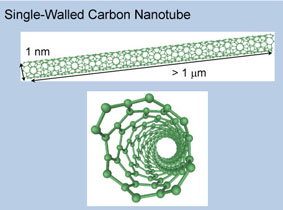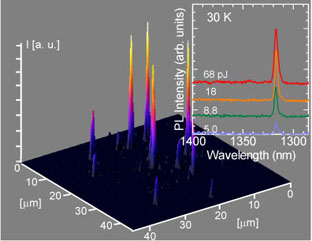Associate Professor MATSUDA, Kazunari, Professor KANEMITSU, Yoshihiko and Their Co-workers “Exciton Dephasing and Multiexciton Recombinations in a Single Carbon Nanotube” (Published in 15 Jan 2008)
|
Associate Professor MATSUDA, Kazunari, Professor KANEMITSU, Yoshihiko and Their Co-workers “Exciton Dephasing and Multiexciton Recombinations in a Single Carbon Nanotube” Published in Physical Review B, 15 January 2008 |
||||
|
Researchers at Institute for Chemical Research and collaborators at the University of Tokyo have revealed a novel optical response in single-walled carbon nanotubes utilizing optical observation of a single carbon nanotube. |
 Associate Professor MATSUDA, Kazunari and Professor KANEMITSU, Yoshihiko |
|||
 Figure 1. Single-walled carbon nanotube |
Carbon nanotube, discovered by Dr. Iijima in NEC laboratory in 1991, is a 1-dimensional material with a characteristic cylindrical structure of only 1 nm diameter and several-μm length (Figure 1). Recently, the carbon nanotubes also have attracted a great deal of attention as a material with optical functionality. The electronic properties are very different from individual carbon nanotubes which makes it difficult to understand the resulting optical properties and functionalities. | |||
| We have revealed that the carbon nanotube shows novel optical response by utilizing spectroscopy of a single carbon nanotube. Figure 2 shows 3-dimensional map obtained by detecting very weak photoluminescence signal from individual carbon nanotubes. The inset of Figure 2 shows photoluminescence spectra of a single carbon nanotube at 30 K. We can obtain various useful information from the photoluminescence spectrum because the photoluminescence arises from the light emission from an “exciton” (hydrogen-atomic-like state composed of an electron and hole pair) and found that the optically generated exciton state in a carbon nanotube keeps quantum coherence for about one picosecond (10-12sec). |  Figure 2. Photoluminescence image of individual carbon nanotubes and photoluminescence spectra of a single nanotube (inset). |
|||
| Furthermore, we found that the “biexciton” composed of two bound excitons (hydrogen-molecule-like state) is not easily formed in a 1-dimensional carbon nanotube, which is much different from the behavior in usual semiconductors. This may be understood by comparing the 1-dimensional carbon nanotube as a “rail” guiding two excitons to collide with each other. Thus, the loss of energy of during exciton collision prevents the bound biexciton formation. Further studies on the development of applications of carbon nanotubes using these novel optical properties are in progress. | ||||
| The research results described above are based on the progress of optical imaging spectroscopy developed by MATSUDA who won the Marubun Research Award for Promotion of Young Scientist on March 2007 and 1st Award for Promotion of Young Scientist in Physical Society of Japan on September 2007 owing to these achievements. | ||||
 Institute for Chemical Research, Kyoto University
Institute for Chemical Research, Kyoto University International Joint Usage Research Center
International Joint Usage Research Center